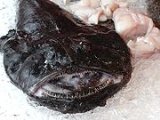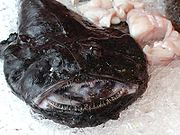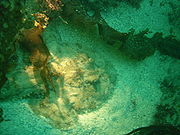
Monkfish
Encyclopedia


Anglerfish
Anglerfishes are members of the teleost order Lophiiformes . They are bony fishes named for their characteristic mode of predation, wherein a fleshy growth from the fish's head acts as a lure; this is considered analogous to angling.Some anglerfishes are pelagic , while others are benthic...
genus Lophius
Lophius
Members of the genus Lophius, also sometimes called monkfish, goosefish, fishing-frogs, frog-fish, and sea-devils, are well known off the coasts of Europe generally, the grotesque shape of its body and its singular habits having attracted the attention of naturalists of all ages...
and the angelshark genus Squatina. The term is also occasionally used for a European sea monster
Sea monster
Sea monsters are sea-dwelling mythical or legendary creatures, often believed to be of immense size.Marine monsters can take many forms, including sea dragons, sea serpents, or multi-armed beasts. They can be slimy or scaly and are often pictured threatening ships or spouting jets of water...
more often called a sea monk
Sea monk
The sea monk, or sometimes monk-fish, was the name given to a sea animal found off the eastern coast of the Danish island of Zealand almost certainly in 1546. It was described as a "fish" that looked superficially like a monk. It was mentioned and pictured in the fourth volume of Conrad Gesner's...
.
Monkfish is the most common English name for the genus Lophius in the northwest Atlantic but goosefish
Goosefish
Monkfish are a family, Lophiidae, of anglerfishes. They are found in the Arctic, Atlantic, Indian and Pacific Oceans where they live on sandy and muddy bottoms of the continental shelf and continental slope, at depths in excess of ....
is used as the equivalent term on the eastern coast of North America. Lophius has three long filaments sprouting from the middle of the head; these are the detached and modified three first spines of the anterior dorsal fin. As in most anglerfish species, the longest filament is the first (illicium), which terminates in an irregular growth of flesh, the esca. This modified fin ray is movable in all directions. This esca is used as a lure to attract other fishes, which monkfish then typically swallow whole. Experiments have shown, however, that whether the prey has been attracted to the lure or not is not strictly relevant, as the action of the jaws is an automatic reflex triggered by contact with the esca.
It grows to a length of more than 1.5 m (5 ft); specimens of 1 m (3 ft) are common. The largest recorded specimen caught weighed 99.4 kg (219 lbs).
Commercial use
Two species, Lophius piscatorius and Lophius budegassa, are found in north-western Europe and referred to as monkfish, with L. piscatorius by far the most common species around the British Isles and of major fishery interest.Under UK Labelling Regulations, the phrase "monkfish" is only permitted for Lophiodes caulinaris, Lophius americanus, Lophius budegassa and Lophius piscatorius.
In Europe and North America, the texture of the tail meat of fish of the genus Lophius, is sometimes compared to lobster tail and has been alluded to as the "poor man's lobster," although today it commands prices equivalent to, and in some cases exceeding, lobster and other marine delicacies. According to Seafood Watch
Seafood Watch
Seafood Watch is one of the best known sustainable seafood advisory lists, and has influenced similar programs around the world. It is a program designed to raise consumer awareness about the importance of buying seafood from sustainable sources...
, monkfish consumption raises sustainability concerns due to past overfishing and damage to the seafloor habitat resulting from the use of trawlers and gillnet
Gillnet
Gillnetting is a common fishing method used by commercial and artisanal fishermen of all the oceans and in some freshwater and estuary areas. The gillnet also is used by fisheries scientists to monitor fish populations. Because gillnets can be so effective their use is closely monitored and...
s to catch this fish.
A second group of fish also known as monkfish are members of the genus Squatina, in the angel shark family Squatinidae. These are of somewhat similar shape to the anglerfish, but completely unrelated; as they are elasmobranchs
Elasmobranchii
Elasmobranchii is a subclass of Chondrichthyes or cartilaginous fish, that includes the sharks and the rays and skates .-Evolution:...
. These fish are only of minor significance for human consumption, though they are endangered because they are caught as bycatch
Bycatch
The term “bycatch” is usually used for fish caught unintentionally in a fishery while intending to catch other fish. It may however also indicate untargeted catch in other forms of animal harvesting or collecting...
by trawlers. Monkfish is commonly eaten in all of Portugal and the northern and southern coastal regions of Spain, such as Catalonia, Valencia and Galicia.

